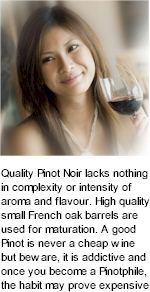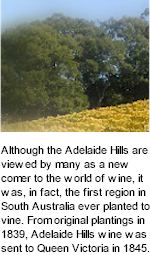


Lindsay Barratt was previously a physician and retired entirely from medicine in 2001 to realise his dream of handcrafting the wine from beginning to end - growing and caring for the vines (which he has done since 1990 when the Uley property was acquired) and, since 2001, taking the grapes through the process of specialised winemaking. After having achieved his Graduate Diploma in Oenology at the University of Adelaide in 2002, he has taken control of all the wine produced under the Barratt label at the Lobethal winery. Barratt sources grapes from two small vineyards, Uley and Bonython, to produce quality wines handcrafted to exacting standards. The Adelaide Hills are a challenging region in which to grow grapes and make win and Lindsay Barratt loves a challenge!

Adelaide Hills is very typically cool climate. Sauvignon Blanc, Chardonnay, Pinot Noir and Merlot are the varieties to flourish in this subregion. But growing grapes in the Adelaide Hills is not an easy task given the weather extremes that are encountered, particularly in the Piccadilly Valley where average rainfall is well over 1,000 mm per year, fruit set is unpredictable and disease pressures are high. Lindsay's philosophy is that the vineyard is all important in the production of top quality wines and his aim is to produce each year the finest wine from the finest grapes that the season and meticulous vineyard care can provide.
The Adelaide Hills winegrowing region is distinctly cool climate and lies above an altitude of 400 metres. Although the Adelaide Hills are viewed by many as a relative newcomer to the world of wine, it was, in fact, the first region in South Australia ever planted with vines. From original plantings in 1839, wine produced from Adelaide Hills vines was sent to Queen Victoria in 1845.
The Adelaide Hills are geographically large with many microclimates and soil types allowing a wide range of varieties to be grown successfully. Typical cool climate varieties of Pinot Noir, Chardonnay and Sauvignon Blanc produce some outstanding wines while in the warmer areas, Cabernet, Shiraz and Merlot are also proving exciting.

With falling consumer interest in dry table wines and great difficulties in controlling fungal disease, grape growing was abandoned in the early twentieth century, but revived again in the 1970s, the foremost new plantings being those of Brian Croser destined to make famous the region and the Petaluma label.
Australia has shown itself to be capable of producing high quality Pinot Noir wines, predominantly from the truly cool climate regions such as Mornington Peninsula, Yarra Valley, Macedon, Geelong, Tasmania and, in South Australia, parts of the Adelaide Hills. Quality Pinot Noir lacks nothing in complexity or intensity of aroma and flavour. Quality is very sensitive to crop size (must be low-cropping), terroir, season and winemaking techniques. It is much more prone to oxidation than other more robust heavier reds and must be protected from this type of spoilage throughout its life. High quality small French oak barrels are usually used for maturation. In consequence, a good Pinot is never a cheap wine but beware, it is addictive and once you become a Pinotphile, your habit may prove quite expensive!
Barratt has produced Pinot Noir since 1993, initially a single wine per vintage but since 2001, Barratt have made an entry level wine from fruit sourced predominantly at the Bonython vineyard planted in 1997, The Reserve mainly from the Uley vineyard planted in 1983 and, more recently a purpose made, elegant, aromatic, dry Pinot Rosé called Piccadilly Sunrise. Barratt Pinot Noir are made to show elegance and have all of the best qualities and characters. Often, they are tight or closed on release but will develop slowly and surely during bottle maturation, exhibiting a wonderfully long life with careful cellaring. Lindsay Barratt hopes you enjoy his efforts with this enchanting grape!
